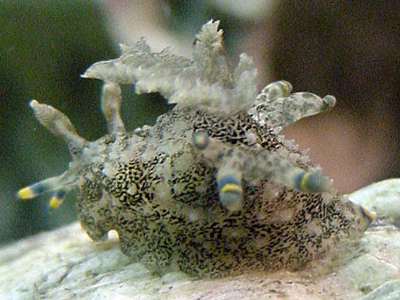Polycera hummi from Florida
January 9, 2004
From: Karen Mudgett


Hello everyone,
We would like help with species identification, if possible. We're on the west coast of Florida [USA], near Tampa Bay. We found this sea slug along the side of a boat dock today, January 6, 2004. The water is no more than 3 to 5 feet deep, depending on tide. The bottom is mostly sand, with a bit of mud.
It's between half an inch and 3/4 of an inch long. On each side of his head there are 2 tube-like projections with 3 rings of color, 2 blue separated by yellow. Directly behind those, there are 2 more projections (1 on each side) without the color bands (antennae?). In the center, towards it's rear, there's a bushy clump (gills?) with 6 more of the color banded projections (3 on each side) below it. He also has tiny bumps all over him, although they seem to be mostly on the back half of him. When we first found him, he was curled up in a little ball and we thought it was going to be a Ragged Sea Hare, as its body colors and pattern were similar to the ones we found in the area at the end of last summer. But as I held him and he opened up, it became clear that this one was different.
I'd like to know what species he is, either scientific name or common name would be helpful, also any information you could share would be appreciated. We checked the Audubon Society field guide with no positive matches.
Thanks,
Karen
anoksunamun@wildmail.net
Mudgett, K., 2004 (Jan 9) Polycera hummi from Florida. [Message in] Sea Slug Forum. Australian Museum, Sydney. Available from http://www.seaslugforum.net/find/11853Dear Karen,
This is an interesting find. It is Polycera hummi, a species which only seems to have been reported twice since it was described in 1952. As far as I know, your photos are the first that have ever been published. It is known only from Florida, Sth Carolina and Nth Carolina, in the southeastern USA, but now we have a photo available it is probable that people will identify it from other parts of the warm water western Atlantic.
As it has been seen so rarely we know little about its biology, but there is one report (Eyster, 1980) of it on the arborescent bryozoan Bugula sp.. Most species of Polycera are associated with arborescent bryozoans and at times large populations of them can be found on their specific bryozoan, feeding, mating and laying egg ribbons. This is the second interesting species of Polycera we have had on the Forum from the southeastern USA recently. Last year, the first photos of Polycera chilluna from North Carolina were published showing that the eastern Atlantic species, Polycera aurantiomarginata is almost certainly the same species.
Photos of other sea slugs from your part of the world would be very welcome as we know suprisingly little about the ones found in your region.
Best wishes
Bill Rudman
Related messages
-
Polycera hummi from Gulf of Mexico
From: Kasey L. Grace, June 1, 2010 -
Polycera hummi from Mississippi, USA
From: Gretchen Grammer, November 21, 2007 -
Re: Polycera hummi from North Carolina
From: Anthony Fernando, December 6, 2006 -
Polycera hummi from North Carolina
From: Tony Fernando, November 22, 2006 -
Re: Polycera hummi from Florida
From: Karen Mudgett, July 11, 2004 -
Re: Polycera hummi from Florida
From: Karen Mudgett, January 12, 2004 -
Egg-ribbon of Re: Polycera hummi
From: Karen Mudgett, January 12, 2004
